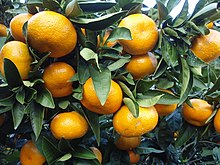Satsuma mandarin
| Citrus unshiu | |
|---|---|
 |
|
| Scientific classification | |
| Kingdom: | Plantae |
| (unranked): | Angiosperms |
| (unranked): | Eudicots |
| (unranked): | Rosids |
| Order: | Sapindales |
| Family: | Rutaceae |
| Genus: | Citrus |
| Species: | C. unshiu |
| Binomial name | |
|
Citrus unshiu (Yu.Tanaka ex Swingle) [[.]] |
|
Citrus unshiu is a seedless and easy-peeling citrus species, also known as unshu mikan,cold hardy mandarin,satsuma mandarin,satsuma orange, and tangerine. It is of Chinese origin, but was introduced to the West via Japan.
In China, it is known as Wenzhou migan (Chinese: 温州蜜柑; pinyin: Wēnzhōu mìgān); in Japan, it is known as mikan, or formally Unshū mikan, the Japanese reading of the characters used in Chinese. In both languages, the name means "honey citrus of Wenzhou" (a city in Zhejiang province, China). An alternative Chinese name, (Chinese: 无核桔; pinyin: wúhé jú), means "seedless mandarin".
One of the English names for the fruit, "satsuma", is derived from the former Satsuma Province in Japan, from which these fruits were first exported to the West.
The Afrikaans name naartjie is also used in South African English. It came originally from the Tamil word nartei, meaning citrus. The word has been used in South Africa since 1790, but the first recorded use in written English is by Lawrence Green in Tavern of the Seas, 1947.
Under the Tanaka classification system, Citrus unshiu is considered a separate species from the mandarin. Under the Swingle system, unshius are considered to be a group of mandarin varieties.
...
Wikipedia
